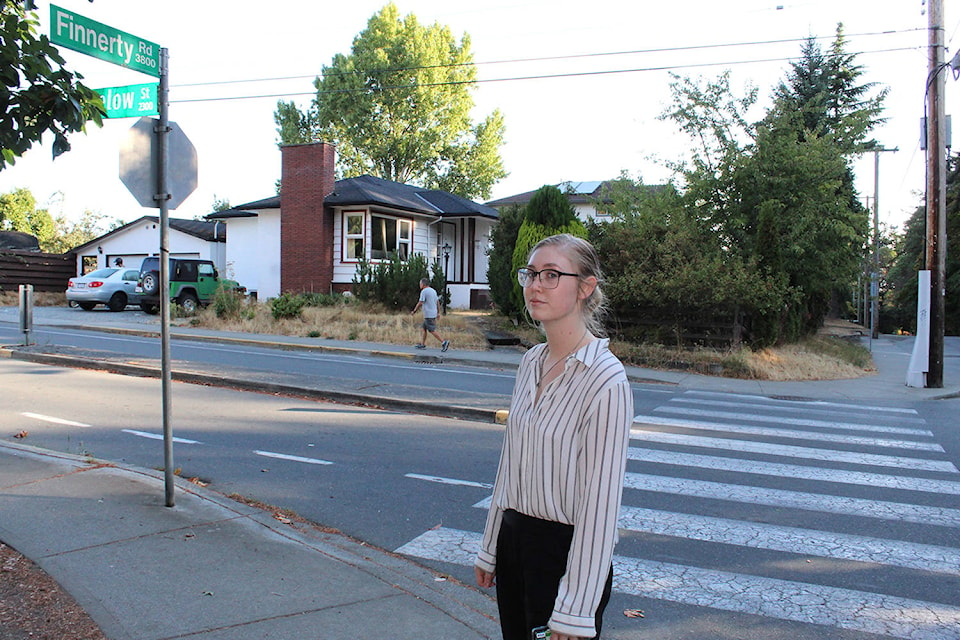Popular culture often paints the first days of university as a period of bliss, free of assignments and full of social events unfolding under a waning but still warming late summer sun.
If it only were so.
As the University of Victoria, Camosun College and Royal Roads University welcome thousands of new and returning students this week, many of them are still looking for off-campus housing, and not because they are picky.
Ainsley Kerr is among them.
Her current bus ride to UVic lasts 90 minutes – far too time consuming. “I’ve been looking in a 25-minute radius around the UVic campus,” she said. Unfortunately, choices in that category appear slim, said Kerr, who describes her search as “draining,” if not “intimidating,” as she often finds herself touring strangers’ homes alone.
What she has seen so far is not impressive.
“I’ve seen dark, tiny basement suites, bathrooms with mould, $900 rooms that will barely fit a queen-sized bed, and a striking number of places so absent of kitchen space that they don’t even have a hot plate,” she said.
Ultimately, the search for off-campus housing comes down to making some difficult choices.
“Most affordable rooms require making a sacrifice in some area, usually privacy, where you end up living with four or five other people you don’t know. Next is distance. There’s nothing unusual about living 90 minutes away from campus. Safety is the biggest concern though.”
Kerr’s frustrations sound familiar to many of her cohorts. But for Kerr, the issue is not just a personal matter. It is also a political matter.
As director of campaigns and community relations for the University of Victoria Student Society, Kerr deals with the issue on a policy level, whose various aspects affect the social fabric of Saanich and surrounding communities.
Of the 18,000 undergraduate students that attend UVic, 78 per cent live off-campus. While some live with their parents or other family members, many are competing with other students and non-students for an increasingly shrinking and therefore unaffordable supply of rental housing with several factors stacked against them.
One, they generally need housing for eight months, but landlords are often looking for a longer commitment. Two, landlords have considerable leverage over rental rates.
“Generally speaking, renting to students is an easy way to make money and people recognize it,” said Kerr. “We need the housing and can’t migrate to cheaper areas the same way someone with a full-time job can. We’re pinned to our schools because they’re what’s creating opportunities for our futures.”
Third, some municipalities have artificially limited the supply of off-campus housing by prohibiting certain types of housing. Restrictive municipal bylaws (such as Oak Bay’s ban on garden suites) continue to restrict what could be accessible options for students, although municipalities have begun to lift some restrictions of late,” she said.
Add it all up and students find themselves increasingly living in substandard housing, whose escalating costs compound the financial burden facing students.
“Rent is the most significant contributor to student debt,” said Zac de Vries, a candidate for Saanich municipal council and former student leader, who recently graduated from UVic. Low vacancy rates also cause stress among students and encourage overcrowding with all its negative effects. “Many people have taken to hanging curtains in the living room and calling it a bedroom,” he said.
Alistair Vigier, a local landlord who also runs the local family law firm Clear Way Law, can confirm, if not sympathize with many of these concerns.
“The demand for housing from UVIC students is massive,” said Vigier, who rents out two houses in Saanich and one in Oak Bay. “I put up an advertisement on Kijiji or Craigslist and within the day my inbox is filled with people wanting to see the house. I do an “open house” and have the groups of students come see the properties. It’s hard to turn some of the students away because a lease has been signed that day. I’ve seen students cry.”
Vigier has been a landlord for six years. Every year has been extremely busy and he does not foresee any change. Vigier and Kerr also agree municipal governments need to do more to improve the supply of affordable housing.
“The biggest impact on rental activities are [municipal bylaws].”
Various efforts are underway. They include lobbying efforts to make post-secondary education in general more affordable. The provincial government has also lifted restrictions that had prevented universities from taking on debt to build on-campus, and UVic plans to build 600 additional beds on campus.
Kerr cheers this development, but only to a point. “This is fantastic and we’re overjoyed with UVic for making the investment but it will not fix the problem.”
Until municipal and provincial governments create more low-income housing for everybody, students and at-large-community members will continue to clash over development goals, said Kerr, an unfortunate phenomenon.
“Students care about more than their on-campus environment,” she said “They care about their communities.”
